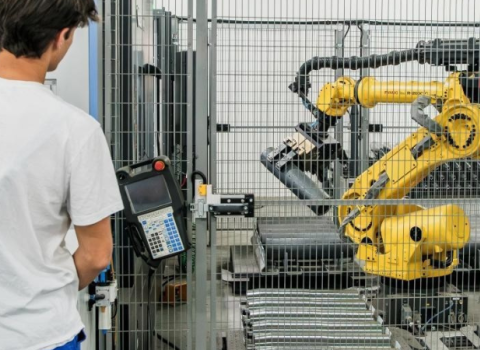Better links between civilian and military technologies are needed “across the board,” says Ursula von der Leyen

European Commission president Usrula von der Leyen speaking at the NATO Summit Defence Industry Forum in The Hague. Photo credits: Aurore Martignoni / European Union
The EU needs to “build more bridges” between the civilian and military domains, European Commission President Ursula von der Leyen has said, just three weeks before she is due to present proposals for the next long-term EU budget instruments.
“Many critical components of 21st-century defence are dual-use: chips, cloud services, software, satellites, artificial intelligence, you just name it. Our defence industry needs seamless access to the high end of these vital technologies,” von der Leyen said during the NATO Summit Defence Industry Forum in The Hague on June 24. “Today, dual-use projects are often not allowed to run on civilian platforms. We have to change this.”
The European Parliament and Council are currently mulling over a proposal from the Commission to allow the European Innovation Council (EIC) Fund to support dual-use and defence-related projects, which would require an exemption from existing Horizon Europe rules.
The Commission also wants to support dual-use projects through the Digital Europe Programme, including with access to the planned AI gigafactories, which will specialise in the training of very large AI models.
Von der Leyen suggested other instruments could also be adapted to embrace dual use. “We will seek this kind of synergy across the board. We must better connect our tech industry with our defence industrial base,” she said.
During this week’s summit, NATO allies agreed to set a new defence spending target of 5% of GDP. This includes raising the previous 2% target for core defence spending to 3.5%, and an additional 1.5% on defence and security-related investments including infrastructure and resilience. But, von der Leyen warned, “how we invest is just as important as how much we invest.” That means modernising defence capabilities and integrating new technologies.
Horizon Europe
The EIC Accelerator already supports many companies with dual use potential, from cybersecurity and AI to drones, and the Commission’s proposal “clarifies that these companies can continue to be fully supported in case of defence applications of their technologies,” Commission spokesperson Thomas Regnier told Science|Business. However, he did not clarify whether other parts of Horizon Europe could open up to dual-use projects.
Last year’s public consultation showed academic institutions are broadly against allowing dual use in the next Framework Programme, while businesses are more open to the idea.
For Manuel Heitor, whose expert group on the future of the Framework Programme recommended embracing dual use, von der Leyen’s comments “are very positive and should be taken very seriously by all of us in Europe.”
“I strongly believe that only a better articulation of research, space and defence programmes in Europe [. . .] will allow the required additional investments which are very necessary to guarantee European strategic autonomy and security,” Heitor told Science|Business. These investments should not be considered within the traditional public deficit control rules, he added.
Heitor, a former Portuguese science minister,, believes defence can be a driver of European economic competitiveness, but this will require increased investments in research and innovation “across all fields of knowledge.”
On June 25, the Commission’s expert group on the economic and societal impact of research and innovation published a policy brief which calls for dual use potential to be exploited to ensure maximum return on research investments. “In a rapidly evolving geopolitical landscape, the ability to coordinate, invest in, and regulate dual use R&D is essential for strategic autonomy and long-term resilience,” the group writes.
“Of course, we know that times are changing and that the boundaries between civil, dual use and military are fading,” said Kurt Deketelaere, secretary general of the League of European Research Universities (LERU).
However, LERU argues that implementing the Heitor report’s recommendation to distinguish only between military research and everything else, including dual use, would be “short-sighted.” If this is the Commission’s plan, the lobby group wants there to be a discussion around safeguards, such as assessing the risk of misuse for research with military potential.
Funding gap
Von der Leyen also used her speech to stress the importance of tackling the funding gap which pushes European start-ups to move oversees in their growth phase, including in the defence sector.
“Since the start of the war [in Ukraine], investment in European defence tech start-ups has increased by 500%. But we still lack funding for the critical stage, from the start-up to the scale-up,” she said. “We need to identify potential unicorns proactively, and channel more capital towards them, both from public and private investors.”
Related articles
- Commission seeks links between civil and military research funds
- Viewpoint: dual-use innovation, a strategic choice for Europe
- Commission wants Horizon Europe to fund dual-use technologies
The Aerospace, Security and Defence Industries Association of Europe welcomed the Commission president’s focus on scale-up funding and bridging the gap between large defence companies and start-ups. “While start-ups hold significant potential for technological innovation, particularly given the on-the-ground experience gained in Ukraine, they also require support to meet NATO’s quality and security standards,” a spokesperson told Science|Business.
As a solution, the industry group suggests creating specialised defence “venture builders” which, unlike traditional venture capitalists, would help launch new companies from ideation to commercialisation. They could support start-ups with resources, expertise and infrastructure, help them to meet security requirements, and provide a bridge to venture capital and financial institutions.
Meanwhile, the summit saw defence ministers approve NATO’s rapid adoption action plan, which aims to accelerate the integration of new defence technologies, including through fast-track procurement and new opportunities for testing and experimentation.





 A unique international forum for public research organisations and companies to connect their external engagement with strategic interests around their R&D system.
A unique international forum for public research organisations and companies to connect their external engagement with strategic interests around their R&D system.